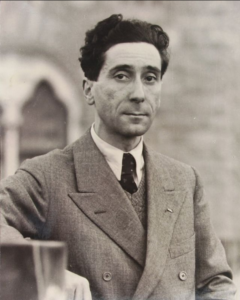
Giorgio Castelfranco was born in Venice on January 18th, 1896. He got a degree in literature at Florence University in 1921; then he won a public competition and began his career in Fine Arts, in many museums, like Taranto, Perugia and (in 1929) Florence, where he was directed by Giovanni Poggi, who praised him for being very careful and precise in his work. After having directed Palazzo Pitti’s Gallery, in 1936, and having set up the Corridoio Vasariano at the time of Adolf Hitler’s visit of Florence, he was sent away from the city because of the fascist racial laws, but found shelter in Bari and Salerno.
In the summer of 1944, after watching over the Allied operations in Naples neighbourhoods, he came back to Tuscany and worked together with Monuments Men and Rodolfo Siviero in taking care of the artworks stored away from Florentine museums to the nearby country depots (mainly Montagnana, Montegufoni and Poppiano) – artworks that were on the path of being stolen by retreating German troops.
From 1946 he worked at Munich’s Collection Point, where Allies gathered stolen artworks waiting to be returned, as a member of the Italian group who had the mission to take the stolen art back.
His last great goal has been to set up the first exhibition of the stolen art recovered in Germany, that took place at Villa Farnesina in Rome between November 1947 and January 1948, together with Rodolfo Siviero.
Giorgio Castelfranco’s classification work between 1944 and 1947 has been fundamental to keep trace of every single artwork, before, during, and after the war, not only for the recovered but also in searching of the missing ones.
